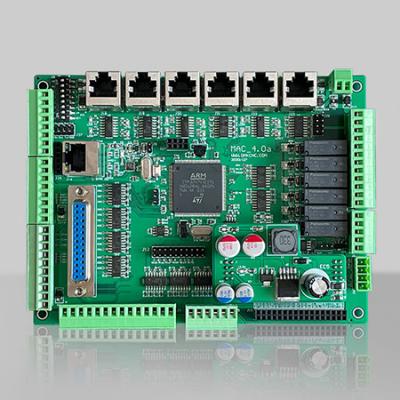6-axis RTCP controller
RTCP-CM600 main advantages:
1. Support 6-axis linkage card, with RTCPfunction and 3+2 directional processing function;
2. Support 18 kinds of machine structures, including double rotary table, single rotary single pendulum, double pendulum head;
3. Support one machine multi-card mode, the use of extended G code, can achieve multi-card collaborative control;
4. Support deep configuration customization of users and rapid secondary development of interfaces; Automatic deployment of functional components;
5. Support 5-axis 3D dynamic processing simulation function;
6. Tool path and G code can realize bidirectional positioning;
7. Support Modbus bus protocol;
8. 3000 lines of super pre-read processing capability, supporting forward-looking path planning;
9. Small line segment processing, better surface, good processing surface, high efficiency;
10. Support macro customization;
11. Support hand wheel guidance, all sports can be guided by hand wheel, such as zero adjustment, knife, knife library, etc.;
12. Support the expansion of disc, in-line, and non-standard tool libraries;
13. Support plane milling, cylindrical milling, and other advanced CAM processing functions;
14. Support fixed tool, floating tool, automatic detection, automatic swing length measurement, etc., and can customize the detection function;
15. Support custom G code, servo spindle, rigid tapping;
16. Support custom function shortcut keys, general input port can be configured as shortcut key;
17. Support array processing, single-stage processing, cycle processing, nearest point processing, and other processing strategies;
18. Support axis mapping;
19. Support rotary shaft encoder;
20. Support a variety of system platforms, including Windows and Linux;
21. Support 4G ultra-large processing files.

RTCP control card for 5-axis CNC machines
This control system is an advanced control system with RTCP core control algorithm, which is used to control multi-axis CNC machining centers and supports 12 types of five-axis machine tool structures of international standards. The operating software is based on the windows operating environment, with fast computing speed and stable performance, and at the same time, it gives the integrator ample space to play.
What is RTCP? The most advanced motion control algorithm at present, commonly known as tool tip follow, the system itself replaces the post-processing conversion process through coordinate conversion, thus simplifying the program code, facilitating machine operation, and supporting more advanced functions. At the same time, this action principle can ensure the accurate position of the tooltip, the efficiency of curved surface processing, and the smoothness of the workpiece surface to the greatest extent.
A true five-axis linkage: False five-axis linkage is to calculate the multi-axis tool path at one time through programming software and post-processor, but the rotation resolution and feed rate of each axis are preset. If the eccentricity is too large Or the tool is too long, the resolution of the distal tooltip cannot be maintained, the speed coordination of each axis is very low, the precision of linkage cannot be guaranteed, and the code file is quite large.
The real five-linkage cannot simply be understood as five axes moving together, but means that the five axes can move at the best speed and interpolation accuracy according to the eccentricity of the rotating axis, to ensure the spatial accuracy of the point position of the tooltip.
Power supply voltage 24v 2A DC
Protection: Provides mains filter
Isolation: onboard USB isolation chip
Communication: USB DMA, USB wire is not more than 2 meters, can be equipped with a special extension line
Shielding: Keep a distance of more than 30CM from high-power electrical appliances in the rain
Five-axis linkage: support multi-axis linkage, support RTCP tool tip follow
Number of Axes: 6 Motion Axes
Speed: up to 300K per axis
Spindle: 0-10v analog output
Input signal: each axis returns to zero and decelerates, in-position, overtravel, emergency stop, tool setting, servo alarm, etc.
Output signal: spindle, water pump, air blow, alarm, tool change, tool magazine, accurate stop, etc.
Handwheel: 6-axis special handwheel, no delay delay
System accuracy: 0.001
Shaft output signal: 5v differential signal
Supported motors: general-purpose pulse-type servo motor (differential), (hybrid) stepping motor (differential)
Support sensor: NPN three-wire normally open, two-wire mechanical
Back to the reference point: the sensor decelerates, and the Z signal of the motor encoder stops accurately
Tool setting length: It can be connected to an electronic tool setting instrument to realize automatic tool setting with an accuracy of 0.003
3D compensation: Mechanism eccentricity compensation, vector compensation; and workpiece coordinate eccentricity compensation can be set
Code format: international standard G code format, compatible with Funac
G code: linear interpolation, circular interpolation, drilling cycle, tool length compensation, etc.
M code: spindle switch, cutting fluid switch, RTCP switch, tool magazine in and out, spindle tool change, pause, cycle command switch, coordinate system tilt, etc.
Code simulation: online simulation of g code, check-over travel, and other issues
Three-dimensional display: display three-axis motion trajectory
Mechanical coordinates: record the mechanical zero point of the machine tool, which is also the reference point for RTCP calculations
Workpiece coordinates: the workpiece coordinate system during processing, which corresponds to the working plane of the program
Relative coordinates: can be manually cleared as a reference position without affecting the coordinate position
Remaining coordinates: the remaining distance from the current position to the end of the program
RTCP coordinates: the absolute position after RTCP is turned on









